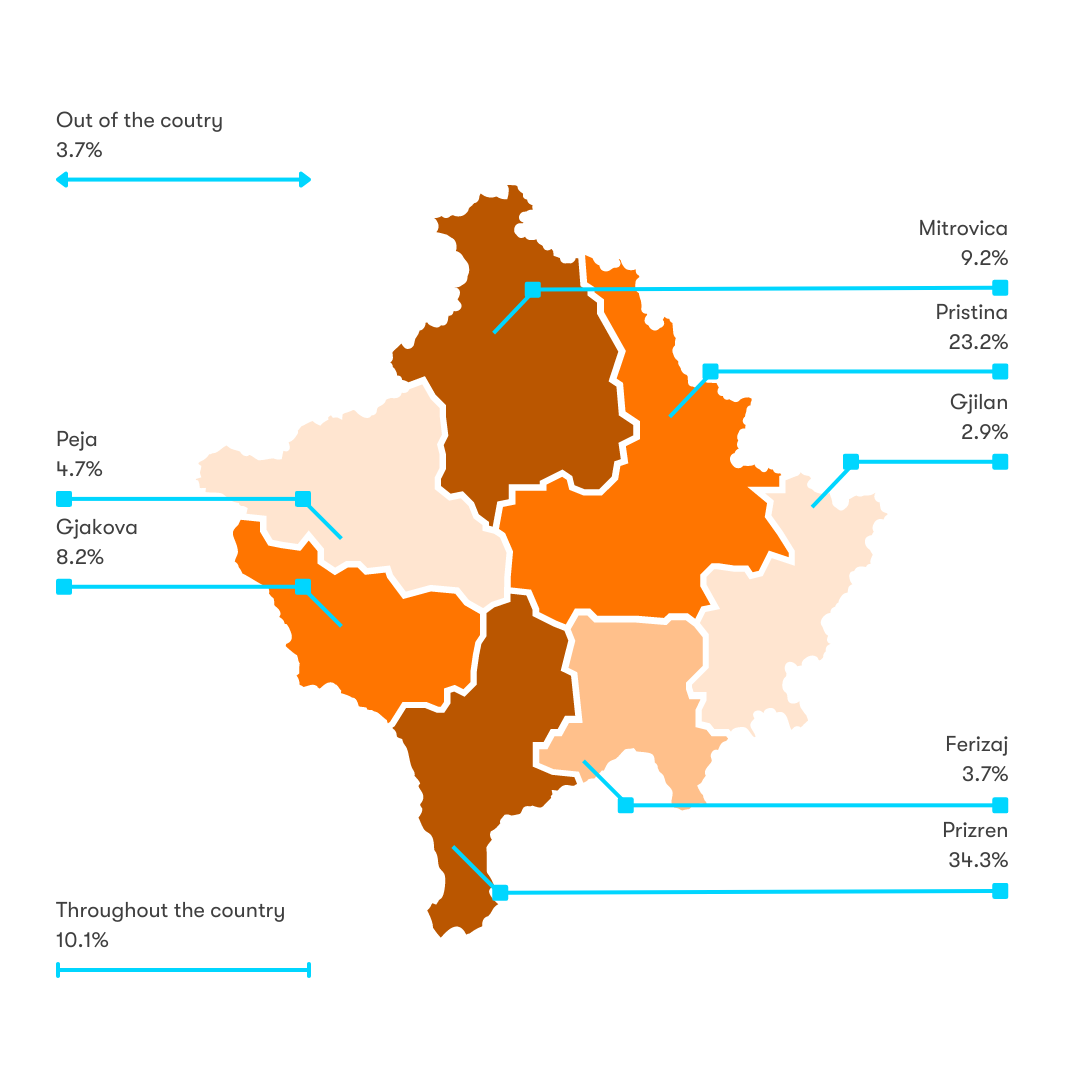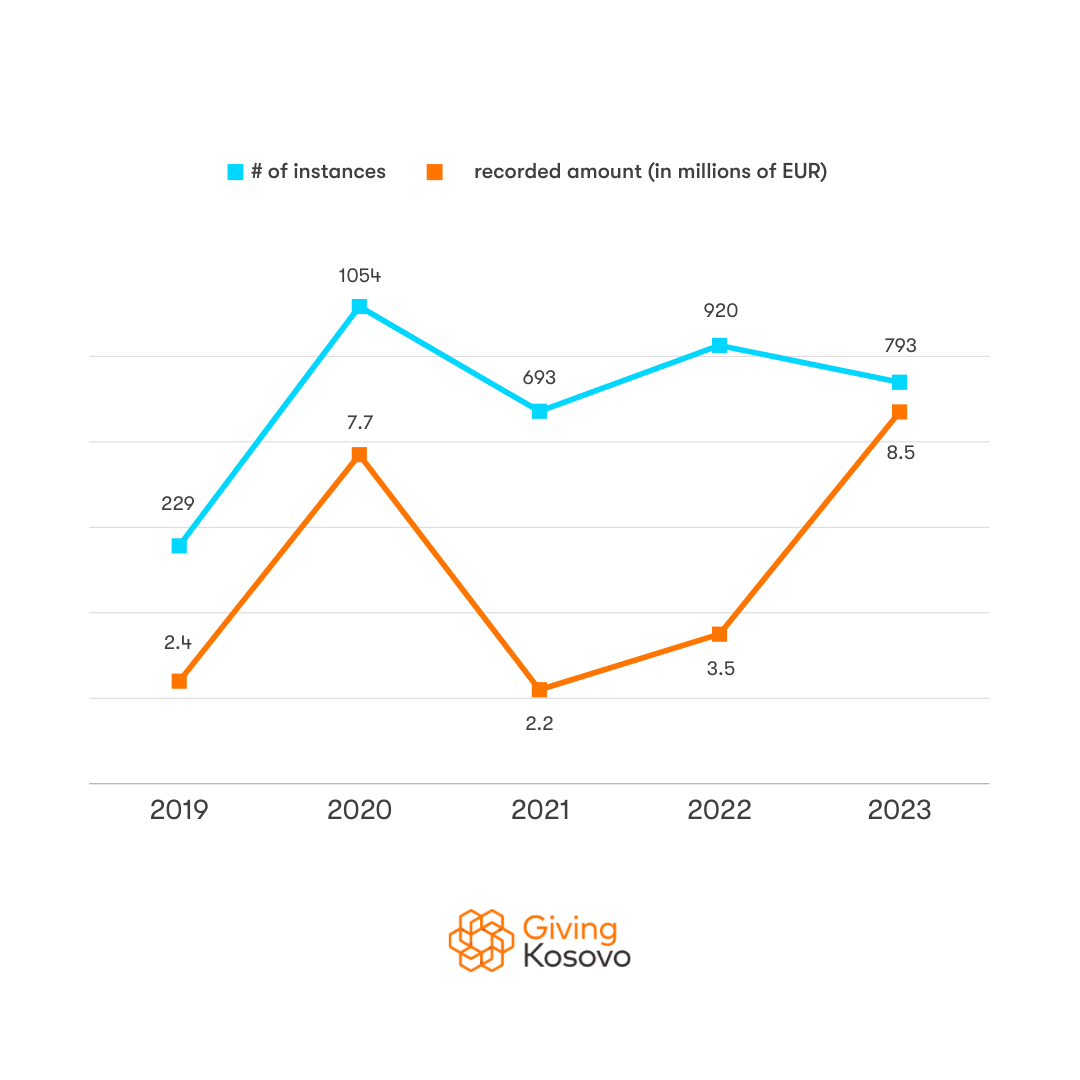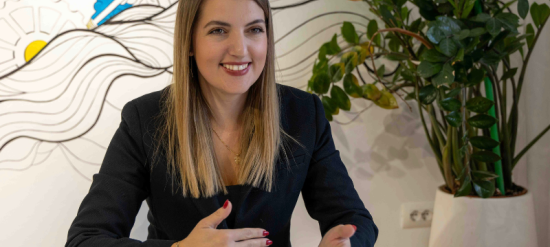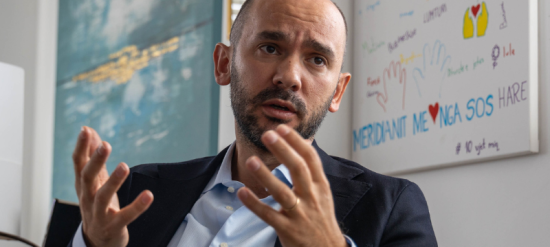Giving Kosovo 2023: Report on the State of Philanthropy
Divider text here
Catalyst Balkans has been tracking philanthropic activities in Kosovo and the Western Balkans since 2013. This report is published in the framework of the Citizen Engagement Activity, implemented by the Kosovar Civil Society Foundation (KCSF), in partnership with the United States Agency for International Development (USAID). Catalyst Balkans is a partner of KCSF in implementing this activity.
Explore the landscape of philanthropy in Kosovo for the year 2023 and delve into the ways in which citizens, organizations, and companies have contributed to social welfare.
TOTAL RECORDED GIVING
8,740,940.3 EUR
Recorded amount
793
# of instances
![]()
5 EUR
Donated per capita
The year 2023 marked the biggest volume of philanthropic support in Kosovo, a volume higher than the amount given during the challenging circumstances created by COVID-19. A significant rise in donation values is attested across all donor types apart from the corporate sector, which remained at the same level as the year prior. Most of the philanthropic support is directed toward poverty relief and aiding individuals facing economic challenges. The enduring prevalence of contributions to poverty relief underscores its status as the most frequently supported cause within the tracked philanthropic initiatives. In terms of the number of donation instances, 2023 marked a slight decrease, although the donated amount increased.
The diaspora continues to play a significant role in Kosovo's philanthropy ecosystem. According to data from Catalyst Balkans’ database, from 2019 until 2023, donors from the diaspora helped the citizens of Kosovo with donations valuing more than 6.7 million euro.
TRENDS OF GIVING
In a remarkable turn of events, there has been an astounding 153% increase in philanthropic contributions, more than doubling the amount compared to the previous year, 2022. This extraordinary surge in donations can be attributed to the commendable efforts of nonprofit organizations tirelessly working towards social causes. The recorded amount this year stands as the highest ever documented, demonstrating a significant milestone in the realm of charitable giving. This remarkable increase translates to a per capita donation of 5 euro, emphasizing the widespread and impactful nature of collective generosity.
CAUSES
In 2023, contributing towards poverty relief emerged as the most prevalent cause among donors, witnessing a 6.3% increase compared to the previous year. Consistent with the prior year, other significant causes experienced comparatively less attention in terms of giving frequency. This included healthcare (9.5%), support for marginalized groups (7%), and education (10.2%). Donations directed towards poverty relief predominantly concentrated on one-off humanitarian support, exemplified by initiatives like distributing food packages and offering individual housing solutions for socially disadvantaged citizens.
Looking at the recorded values, 30.9% was recorded for poverty relief and 26.5% for support to marginalized groups. The support to marginalized groups was mainly devoted to elderly people i.e. the 2 million euro pledged to build an elderly care facility in Podujeva.
DONORS
This year nonprofit organizations emerged as the most active donor type, with a significant 41.6% share of donor instances, representing a 27.3% increase from 2022. Mass-individual Giving (giving by many unnamed donors collectively), the dominating category of 2022, witnessed a decrease of 13%. Known individuals remained the second most frequent donor type with a 25.3% share in instances of giving.
Concerning the value of donations, the most generous donor categories were citizens, who contributed 45.8% of the share through mass individual giving, and mixed donors, who contributed a substantial 27.9% of the value share.
Diaspora giving marked similar trends, with a 16.4% share in the total number of donation instances and 14% of the total value.
RECIPIENTS
In 2023, individuals and families were the largest category of recipients constituting 52.6% of the total number of donation instances, displacing nonprofit organizations which held the leading position in 2022. This marked the return of the trend observed in the preceding years, when donations were predominantly directed toward individuals and families in need. Notably, donations routed to the state, including institutions of local/national governments and public institutions, received a comparatively smaller share in 2023.
On the other hand, nonprofit organizations (associations and private foundations) received more than half (59.7%) of the total value.
FINAL BENEFICIARIES
In 2023, individuals facing economic challenges continued to be the primary beneficiary group with 62% of all the recorded donations. This figure remains similar to the levels observed in 2022, affirming the continuation of a trend initiated in 2020. Notably, this particular beneficiary group also garnered the largest share of the total recorded value with over 2.7 million euro or 31% of total donations.
While the frequency of support for the local community population experienced a slight increase in 2023, other beneficiary groups maintained the same level.
INTENDED EFFECTS OF GIVING
Nearly 85% of all the donation instances were one-off contributions. Predominantly, this support was directed towards providing individual housing and essential supplies for individuals facing economic challenges. Strategic support, focusing on equipment and scholarships, constituted a smaller proportion of the donation frequency (5% respectively).
The recorded value echoed a similar pattern, with short-term giving dominating and accounting for a substantial 63.9% share.
GEOGRAPHIC DISTRIBUTION OF GIVING
Much like the preceding year, the philanthropic trends in 2023 revealed that Prizren continued to witness the highest number of donation instances. Prishtina stood second with 26.7% while all other regions recorded 10% or less of the total number of donation instances.

Get the infographic to see the data about giving in Kosovo in 2023.
To learn more about our methodology, please read: Methodology
This report is made possible by the generous support of the American people through the United States Agency for International Development (USAID). The contents are the responsibility of Catalyst Balkans and do not necessarily reflect the views of USAID or the United States Government.

Highlights
Take a look at our daily selection of the most inspiring stories about giving in the Balkans.
#IDPwD24: Insights from Kosovo’s Philanthropy Trends
Charity is a powerful way for individuals to make a difference in their...
Crowdfunding has revolutionized how communities can support important causes...
Blog
Read our weekly tips, success stories and best practices for the nonprofit sector.
In today’s fast-paced digital world, capturing attention is harder than ever...
In an increasingly digital world, civil society organizations (CSOs) are...
World Mental Health Day, celebrated every year on October 10, emphasizes the...
Interviews
Read our weekly tips, success stories and best practices for the nonprofit sector.
In recent years, the IPKO Foundation has taken on an important role in...
“Freesia" Paper Factory is the only one in the region with the mission of...
Founded in October 2012 as a new concept of neighborhood markets, the company...









